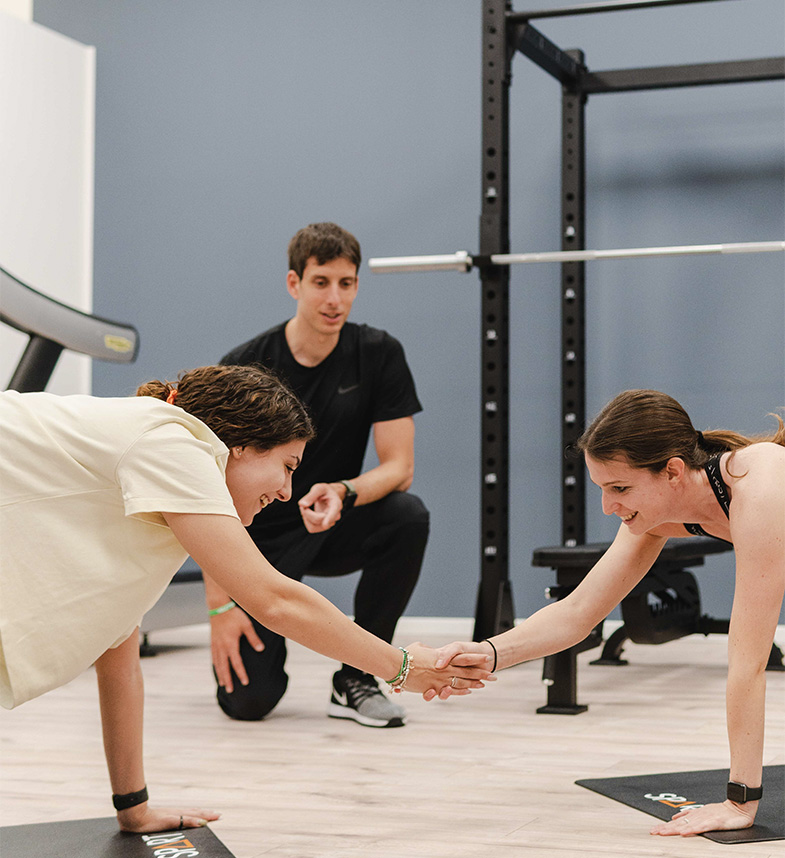Squats and lunges
used to improve leg strength and core stability.
Functional training is a type of workout that focuses on movements and exercises that mimic those performed in daily life. The primary goal is to enhance the body's ability to carry out everyday activities with greater efficiency, strength, and endurance. Unlike other types of training that target specific muscle groups, functional training aims to improve overall body movement by working on strength, mobility, balance, coordination, and stability.

Exercises are designed to mimic the natural movements the body performs daily, such as bending, lifting, pushing, pulling, walking, running, or climbing stairs. This type of training enhances the ability to execute these actions more effectively and safely.
Functional training engages multiple muscle groups simultaneously, rather than isolating specific muscles as traditional gym machines do. Exercises typically require the use of stabilizers and the core (abdominal and lower back muscles), helping to improve posture and stability.
Exercises are not limited to unidimensional movements (such as lifting weights in a single direction) but often involve movements in multiple directions, including rotations, swings, and bends. This helps improve agility and prevent injuries.
Functional training can incorporate tools such as kettlebells, medicine balls, resistance bands, free weights, and even bodyweight resistance. These tools provide different stimuli and intensities to enhance overall body movement.
Functional training focuses on improving basic motor skills, helping to strengthen joints and muscles in a balanced way, reducing the risk of injuries. Additionally, by enhancing stability and mobility, it helps prevent muscle or joint pain, which is common in those with repetitive or sedentary activities.
Exercises are designed to mimic the natural movements the body performs daily, such as bending, lifting, pushing, pulling, walking, running, or climbing stairs. This type of training enhances the ability to execute these actions more effectively and safely.
Functional training engages multiple muscle groups simultaneously, rather than isolating specific muscles as traditional gym machines do. Exercises typically require the use of stabilizers and the core (abdominal and lower back muscles), helping to improve posture and stability.
Exercises are not limited to unidimensional movements (such as lifting weights in a single direction) but often involve movements in multiple directions, including rotations, swings, and bends. This helps improve agility and prevent injuries.
Functional training can incorporate tools such as kettlebells, medicine balls, resistance bands, free weights, and even bodyweight resistance. These tools provide different stimuli and intensities to enhance overall body movement.
Functional training focuses on improving basic motor skills, helping to strengthen joints and muscles in a balanced way, reducing the risk of injuries. Additionally, by enhancing stability and mobility, it helps prevent muscle or joint pain, which is common in those with repetitive or sedentary activities.
By engaging multiple muscle groups and performing functional movements, the body becomes stronger and more resilient, improving performance in other physical or sports activities.
Functional training enhances proprioception, the body's awareness in space, which is essential for maintaining balance and coordination in daily activities.
Since many exercises involve wide and varied movements, functional training helps increase flexibility and joint mobility, reducing the risk of muscle stiffness and improving posture.
Functional training is highly effective in enhancing body composition, as it promotes high energy expenditure and the development of lean muscle mass. By increasing muscle mass and reducing body fat, it helps achieve a more toned and sculpted physique while boosting metabolism and overall well-being.
Functional training not only increases muscle strength but also optimizes movement efficiency, leading to benefits that extend into daily life, such as improved agility, better walking posture, and overall healthier body alignment.
Natural20 offers you a free initial session to meet our personal trainers, see the training environment, and evaluate the most suitable program for your needs together.
